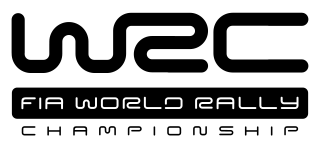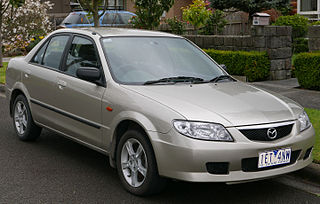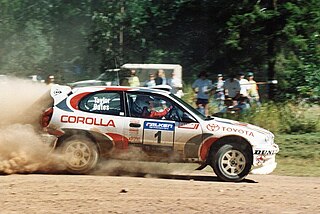
The World Rally Championship (WRC) is a rallying series organised by the FIA, culminating with a champion driver, co-driver and manufacturer. The driver's world championship and manufacturer's world championship are separate championships, but based on the same point system. The series currently consists of 14 three-day events driven on surfaces ranging from gravel and tarmac to snow and ice. Each rally is split into 15–25 special stages which are run against the clock on closed roads.
Castrol is a British global brand of industrial and automotive lubricants offering a wide range of oils, greases and similar products for most lubrication applications.

Chris Atkinson is a professional rally driver. In the WRC, he drove for the Subaru World Rally Team from 2004 to 2008. His best finish on an individual WRC event is second, which he achieved at the 2008 Rally México and Rally Argentina. Other podium placings include third-place finishes at the 2005 Rally Japan and the 2008 Monte Carlo Rally.

The Australian Rally Championship (ARC) is Australia's leading off-road motor rally competition. A multi-event national championship has been held each year since 1968.
The Asia-Pacific Rally Championship (APRC) is an international rally championship organized by the FIA encompassing rounds in Asia and Oceania. Group N cars dominated the championship for many years but in recent years cars built to R5 and S2000 regulations have tended to be the frontrunners.

Elfyn Rhys Evans is a British rally driver from Wales who competes in the World Rally Championship.

Kenneth Block is a professional rally driver with the Hoonigan Racing Division, formerly known as the Monster World Rally Team. Block is also one of the co-founders of DC Shoes. Over the years, he has also competed in many action sports events including skateboarding, snowboarding, and motocross. Since selling his ownership of DC Shoes, Block has shifted his business focus to Hoonigan Industries, an apparel brand for auto enthusiasts. He is currently the co-owner and "Head Hoonigan In Charge" (HHIC) at the company..

The Castrol International Rally was a major Australian rally held in the forests around Canberra, between 1974 and 1981.
Cody Crocker is an Australian rally and racing car driver. Crocker won seven titles between 2003 and 2009 and with 24 wins and four consecutive championships is the most successful driver in the history of the Asia-Pacific Rally Championship.

Scott Pedder is an Australian rally driver who won the 2014 Australian Rally Championship driving a Renault Clio.

The 2010 Australian Rally Championship is series of six rallying events held across Australia, including the international event 2010 International Rally of Queensland. It is the 43rd season in the history of the competition.
The 2010 Asia-Pacific Rally Championship season is an international rally championship sanctioned by the FIA.
The 2011 Asia-Pacific Rally Championship season is an international rally championship sanctioned by the FIA. The championship is contested by a combination of regulations with Group N competing directly against Super 2000 cars for points. While the majority of competitors are privately funded, Malaysian manufacturer Proton enters a factory team of Super 2000 Proton Satria's for Australian driver Chris Atkinson and Scot Alister McRae.
The 2012 Asia-Pacific Rally Championship season is an international rally championship sanctioned by the FIA. The championship is contested by a combination of regulations with Group N competing directly against Super 2000 cars for points. Australian driver Chris Atkinson won the championship he narrowly lost the previous year, beating the Proton R3 Rally Team he raced for in 2011. His Škoda Fabia won the Rally of Whangarei as well as his home event the International Rally of Queensland as well as finishing second in New Caledonia, Malaysia and China, building up a lead his 2011 team mate and defending champion Alister McRae could not catch once his Proton Satria Neo started winning at the Malaysian Rally and the season ending China Rally. The only other rally winners were Indian Skoda driver Gaurav Gill at the Rallye de Nouvelle Calédonie and Malaysian Proton driver Karamjit Singh. Super 2000 cars dominated results with only New Zealand driver Brian Green finishing in the top three at any event in a Group N car.
The 2013 East Coast Bullbars Australian Rally Championship is the 46th season of the Australian Rally Championship, one of the worlds oldest continuously run rally championships. The season began 1 March at the newly revived National Capital Rally, and is scheduled to end 16 November at Rally Victoria, after six events.
The 2013 Asia-Pacific Rally Championship season is an international rally championship sanctioned by the FIA. The championship is contested by a combination of regulations with Group N competing directly against Super 2000 cars for points. A new rally was added to the calendar, the first since Rally of Queensland in 2009, in the Thailand Rally.
The Rallye de Nouvelle-Calédonie is a rally racing event held in the French island of New Caledonia. The rally dates back as far as 1967 and was known then as the New Caledonia Safari. That first rally was won by Australian driver John Keran driving a Volvo 122S. The rally was promoted to international status as a round of the Asia Pacific Rally Championship (APRC) in 1999. In 2000 the rally was dropped from the APRC but returned in 2001 and has been part of the regional championship ever since, although the 2003 event was abandoned due to heavy rain.
The International Rally of Queensland, known previously as Rally Queensland, is a rally racing event held in the Gympie Region of Queensland, Australia run by the Brisbane Sporting Car Club. The rally was based for most of its out of the state capital Brisbane but in more recent times has moved north along the coast to various centres in the Sunshine Coast area. The rally begins in Caloundra before moving inland to forest roads in near Imbil and Kandanga. The rally was first held in 1968 as part of the original Australian Rally Championship and has been part of the ARC ever since.
The 2014 Asia-Pacific Rally Championship season was an international rally championship sanctioned by the FIA. The championship was contested by a combination of regulations with Group N competing directly against Super 2000 cars for points.
The 2017 Asia-Pacific Rally Championship season was an international rally championship sanctioned by the FIA. The championship was contested by a combination of regulations with Group R competing directly against Super 2000 cars for points.














